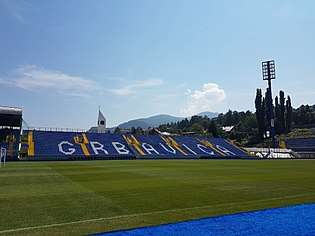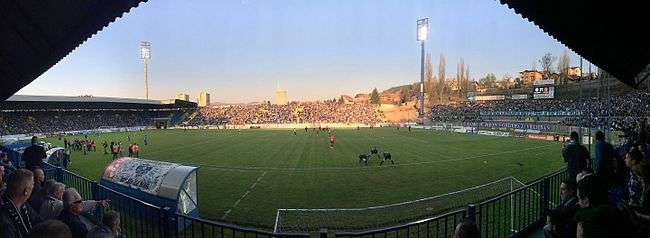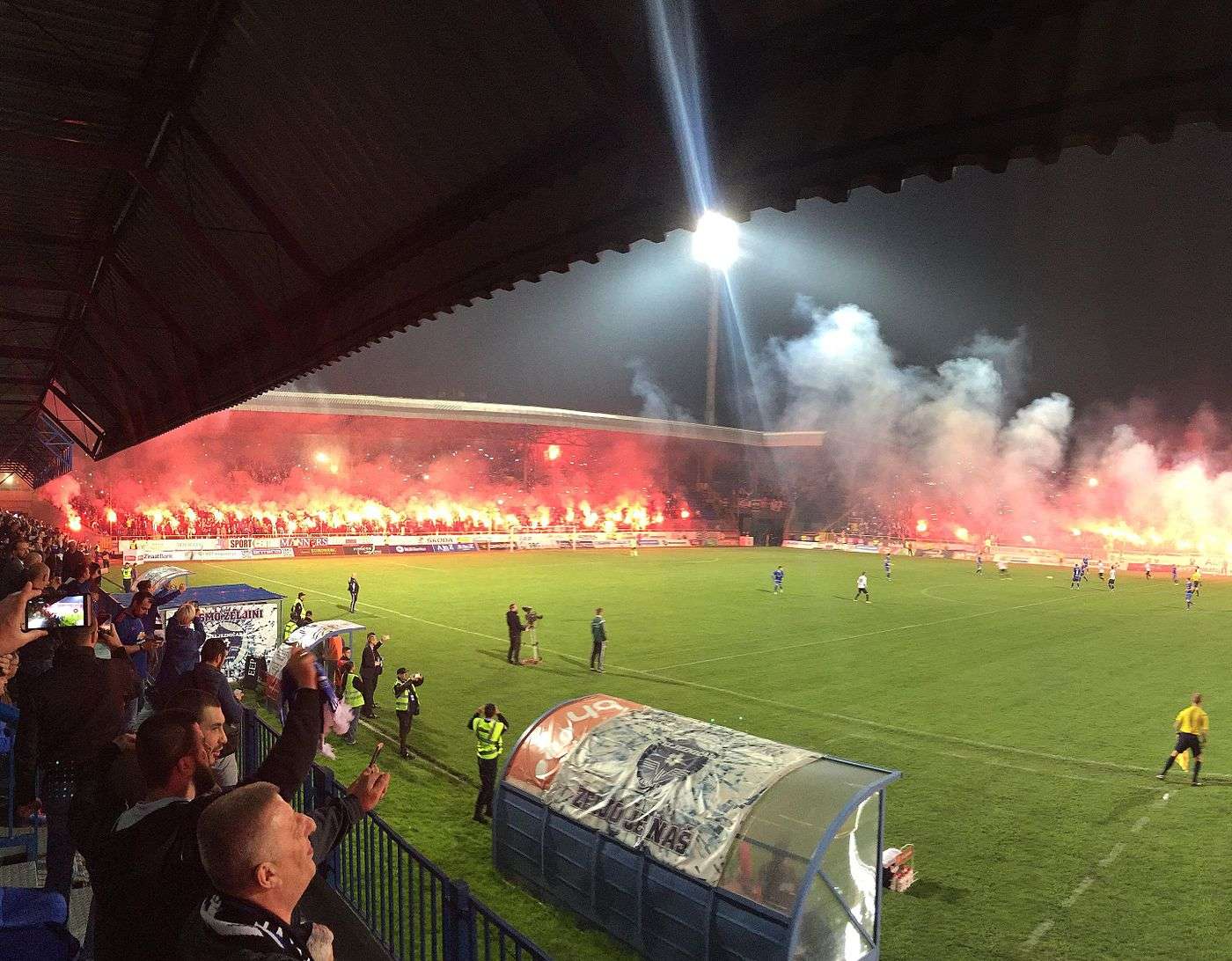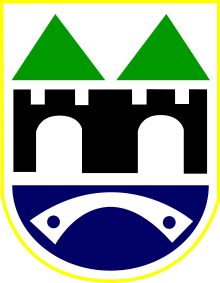Stadion Grbavica
| Dolina ćupova | |
 Grbavica Stadium - UEFA | |
| Location | Ulica Zvornička 21, Grbavica, Sarajevo, Bosnia and Herzegovina |
|---|---|
| Coordinates | 43°50′48″N 18°23′14″E / 43.84667°N 18.38722°ECoordinates: 43°50′48″N 18°23′14″E / 43.84667°N 18.38722°E |
| Owner | FK Željezničar Sarajevo |
| Capacity | 13,785 (League Matches) |
| Field size | 105 x 66 m (114.8 x 72.2 yd) |
| Surface | Grass |
| Construction | |
| Built | 1949–53 |
| Opened | 13 September 1953 |
| Renovated |
25 April 1976 2018 |
| Expanded | 2017 |
| Construction cost |
> €2 million |
| Tenants | |
| FK Željezničar Sarajevo (1953-1968, 1976-present) | |
Grbavica Stadium is located in Grbavica, Sarajevo, Bosnia and Herzegovina. The football stadium has terraces close to the pitch and it is the home of FK Željezničar. The stadium has a capacity to hold 13,785 seated spectators, with more room for standing spectators under South stands (capacity up to 16,000). Grbavica Stadium is also known as Dolina ćupova (en. Plain of Jars).[1]
Construction
The building of the football ground in Grbavica started during the late 1940s by SD Željezničar. Although there were several football pitches with bleachers and stands in Sarajevo at the time (including the freshly built Koševo Stadium), it was decided by communist authorities that Željezničar should have its own playing facility. Many of the club's supporters, friends, and members, including a number Yugoslav People's Army personnel helped in the construction of the stadium. Unlike Koševo that was a large-scale project with generous state support through funds and manpower, Grbavica had a lot fewer people working on it and as a result took much longer to complete. A new pitch with a drainage system was built and the stands were built with concrete. The south and east side were made out of concrete, while wooden stands that were taken from the Marijin Dvor ground that was torn down, got placed on the west side. At first, Grbavica was a multi-use stadium. Competitions in cycling and athletics were organized, as well as football matches. Eventually its use became football only. It was officially opened on September 13, 1953 with the Yugoslav Second League western division match between Željezničar and Šibenik. Željezničar won 4–1.
1970s renovations
In 1968 renovations on the stadium began and on April 25, 1976 Grbavica was re-opened. About 50,000 cubic meters of materials were used, and the floodlights were installed. Two training pitches and the "little sports stadium" were added, as well as new dressing rooms, showers and other important facilities. The Đurasović family were the first donors
1986: Northern stand added
In 1986 a proper northern stand was finally built. There were plans for the whole stadium to be remodeled and encircled to look like the newly built north stand, but they got shelved for the time being. As a result of the renovations, in October 1987, Yugoslav national football team (coached at the time by Željo legend Ivica Osim) played its first ever match at the stadium. In a Euro 88 qualification clash versus Northern Ireland, Yugoslavia won 3–0.
The stadium suffered heavy structural damage during the Bosnian War that broke out in 1992. The stadium was located between the first front lines and endured heavy fighting. Bosnian Serbs' forces burned the West stand wooden terraces. It was not until 1996 that a football match would be played here again. Symbolically, the first match after the war was the local derby. The capacity of North stands holds 5377 seats.[2]
It was partly remodelled in following years. In 2004, 8898 seats were installed on the north and south stand and some small work was done to the terraces. The last major job done on the stadium was in 2008–09 when the floodlights were repaired. On 22 April 2009, after about 18 years, a game under floodlights was again played on Grbavica. There are new proposals for a major overhaul of the current facilities. The new project proposes the creation of new roofed terraces on each side, and the increase of the capacity to 24,000 seated places. Other facilities such as a training ground near the stadium are proposed. These new proposals are still waiting financial backing.
On Monday, 13 February 2012, a section of the roof above the west stand collapsed after 10 days of heavy snowfall. The main reason for the collapsing of the roof was the bad maintenance of the whole terrace and roof were the snow was not removed since the first snowfall, but also the war damages on the buildings.
As at 2016, West stands hold 690 seats since May 2016, while south stands capacity is 3068 seats. A modern LED Display has been installed in the south stand. [3]
2017: Eastern stand added

East stand was rebuilt (an all seated stand replacing the entire East standing section) with works finishing in early April 2017. The capacity of east stands is 4650 seats.[4][5][6] The East stand was funded entirely by club supporters and local businesses.[7][8] United States midfielder Mix Diskerud donated funds to the project by buying 50 seats for the North stand as well as two ten year passes for East stand.[9][10] Former club managers and players the likes of Amar Osim, Edin Džeko, Ibrahim Šehić and Semir Štilić among others, also donated.[11] Regional clubs also supported the project, with donations coming from Dinamo Zagreb.[12][13]
On 1 April 2017, Željezničar played host to Sloboda Tuzla during the Championship round of the 2016–17 Premier League season and on the day the newly built Eastern Stand opened to public.
Location
The stadium is located in the Grbavica neighbourhood, under the Šanac Hill which was traversed by railway tracks. When the train was passing over the stadium, it would sound its horn to salute the crowd. Nowadays, the old railway is no longer in use. There are however trolleybuses that pass by the stadium and visitors are able to come to the stadium using other modes of public transportation as well. The tramway line is also very close near the Socijalno station, which is located 600 meters away from the stadium.
Notable matches
By far the most notable match played at the stadium was the 1984-85 UEFA Cup semifinal return leg on Wednesday, 24 April 1985 between Željezničar and Hungarian visitors Videoton FC from Székesfehérvár. Videoton brought a 1–3 advantage from the first leg, however, the home side fought valiantly in front of the racous home crowd of 27,000 fans[14] and was 2–0 ahead on goals by Edin Bahtić in the 5th and Edin Ćurić in the 62nd minute. Just a few minutes from the end, Željo still had a result that would see it take on mighty Real Madrid in the UEFA Cup final. However, disaster struck in the 87th minute when Videoton right back József Csuhay was left unmarked and scored a goal for 2–1 that took his team to the final and saw Željezničar's hopes dashed in the cruelest of fashions.
Anniversaries
- As part of the 50th birthday celebration on 16 June 1971, Željezničar played Inter Milan. Final result was 3-3 (however location was Koševo Stadium).
- As part of the 55th birthday celebration for the Željezničar (and 90th birthday celebration for Arsenal) played at Stadion Grbavica on August 16, 1976, Željezničar pulled out a friendly 1-1 draw with Arsenal.[15][16]
- As part of the 60th birthday celebration for the Željezničar, in 1981, Yugoslavia national team played with Željezničar at Grbavica Stadium.
- As part of the 80th birthday celebration for the Željezničar, on October 2, 2001, the team welcomed Bundesliga side Wolfsburg with goals scored by Muharemović and Nermin Fatić FK Zeljo won 2-0.[17]
- As part of the 90th birthday celebration for the Željezničar, on November 8, 2011 the team welcomed a full strength national football team of Bosnia and Herzegovina and played a friendly that finished 1-2 in favor of the visitors. The scorer for the national team was Vedad Ibišević with two goals. The lone scorer for Željezničar was Mirsad Bešlija.[18]
International matches
Senior teams only.
| Date | Result | Competition | ||
|---|---|---|---|---|
| 14 October 1987 | 3–0 | UEFA Euro 1988 Q | ||
| 15 August 2001 | 2–0 | Friendly | ||
| 27 March 2002 | 4–4 | Friendly | ||
| 10 August 2010 | 1–1 | Friendly | ||
| 7 October 2017 | 3–4 | 2018 FIFA World Cup Q | ||
| 15 October 2018 | 2018–19 UEFA Nations League B | |||

Concerts
Due to its smaller size (to Stadium Koševo), the stadium has seen far less music concerts held at its location. Some concerts at Stadium Grbavica were:
- On 25 July 1999, The Kelly Family held a concert. [19]
- On 6 July 2013, Mladen Vojičić Tifa held a concert.[20]

See also
References
| Wikimedia Commons has media related to Grbavica Stadium. |
- ↑ "Kako je stadion Grbavica dobio nadimak "Dolina ćupova"". Radio Sarajevo.
- ↑ www.scsport.ba, Sport Centar -. "SPORT CENTAR - Smiješ znati sve o sportu".
- ↑ "Započeo projekat renoviranja Stadiona Grbavica".
- ↑ "FOTO: Bageri na Stadionu Grbavica".
- ↑ "FOTO \\ Željo pravi novu Grabavicu za europske i utakmice reprezentacije".
- ↑ "Započeli radovi na renoviranju stadiona FK Željezničar".
- ↑ "FOTO- Niklo plavo čudo usred Sarajeva".
- ↑ "I Copa90 objavio reportažu o Želji, Manijacima i obnovi Grbavice".
- ↑ "Reprezentativac SAD-a Mix Diskerud kupio dvije 10-godišnje ulaznice za istočnu tribinu Grbavice".
- ↑ www.scsport.ba, Sport Centar -. "Američki reprezentativac Mix Diskerud ponovo podržao izgradnju Grbavice – Sport Centar". scsport.ba.
- ↑ "Evropska Grbavica: Džeko, Šehić, Štilić i Osim donirali sredstva za 120 stolica". Novinska agencija Patria.
- ↑ "Dinamo Zagreb kupio pet, Zdravko Mamić jednu desetogodišnju ulaznicu za Grbavicu".
- ↑ "GNK Dinamo Zagreb podržat će izgradnju istočne tribine Stadiona Grbavica".
- ↑ Željezničar je prije 60 godina dobio dom, svoju Grbavicu;klix.ba, 13 September 2013
- ↑ woolwicharsenal.co.uk. "Željezničar and Arsenal: 15 August 1976". woolwicharsenal.co.uk. Retrieved 2015-08-15.
- ↑ zeljeznicarfk.blogspot.co.uk. "Željezničar - Arsenal 1-1". zeljeznicarfk.blogspot.co.uk. Retrieved 2015-08-15.
- ↑ "Plavi vremeplov: Željezničar – Wolfsburg". fkzeljeznicar.ba. Retrieved 14 August 2015.
- ↑ scsport.ba (November 8, 2011). "Željo odlično sparingovao Zmajevima" (in Bosnian). scsport.ba. Retrieved 2011-11-08.
- ↑ http://bhkoncerti.blogspot.ba/2012/09/kelly-family-30-01-1999-bht-sarajevo.html
- ↑ "Tifa na našoj Grbavici".
External links
- Željezničar football club - Official


